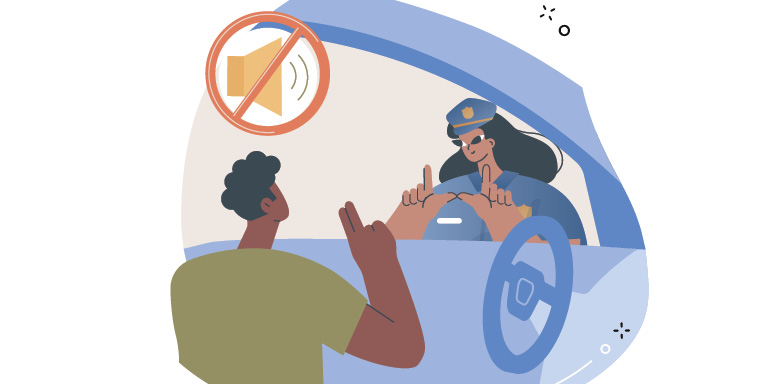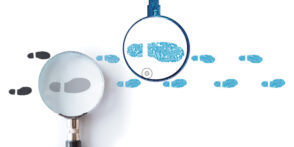Bridging the Communications Gap
Motor vehicle offices use a variety of tools to communicate with drivers who are deaf or hard of hearing
According to the Center for Hearing and Communications, 48 million people in the U.S. experience some form of hearing loss. From complete deafness to partial loss, the disability can impact their everyday lives in many different ways, including driving on the nation’s roads. Communicating with these drivers can become complicated unless highway patrol officers and DMV staff are trained to manage the encounters
properly. Visual aids, electronic devices, communications cards and ASL instructional videos can improve communications with these drivers and ensure that they receive the same level of service as other customers.
DMVs and highway patrol offices have many programs and initiatives in place to assist drivers who have hearing difficulties.
Nebraska DMV
While many DMVs provide interpreters of American Sign Language (ASL) when requested, the Nebraska DMV takes it a step further by offering a driver knowledge test in ASL. The agency partnered with the Nebraska Commission for the Deaf and Hard of Hearing, which provided the sign language expertise on the project, says Rhonda Lahm, executive director of the Nebraska DMV.
In a rural state like Nebraska, most residents depend on their vehicles to travel from place to place and there are few public transit options, except in some larger towns. Offering an ASL driving test makes it easier for the deaf or hard of hearing to function in society, Lahm says.
When an individual arrives at the DMV, they notify staff that they have difficulty hearing. The staff offers the ASL test option. “It’s always the applicant’s choice which version of the test they choose to take,” Lahm says. With the ASL test, there’s less need for interpreters.
The Nebraska DMV has provided other resources for the deaf. During the pandemic when masking was common, for example, the DMV provided see-through masks so lip-reading drivers could understand employees. There’s also an ASL instructional video that explains how to use the agency’s online services for basic tasks such as renewing a driver’s license. In the video, one employee gives the instructions while another staff person interprets them in sign language.
“These drivers are part of our base, so we’re always looking for ways to better serve them,” Lahm says.
Virginia DMV
Waiting at the DMV for an ASL interpreter to be called can be frustrating for some drivers. To cut down on waiting times, the Virginia DMV began using a new wireless communications device called Ubiduo, which consists of a small screen and keyboard. Two Ubiduo devices are connected to one another so the DMV employee can type questions on one keyboard while the customer responds using the other device, allowing for face-to-face conversation in real time.
“While we still use interpreters, Ubiduo helps us process transactions more immediately,” says Fran Kelly, SecuriTest program manager at the Virginia DMV, who was the lead on the project.
The devices were financed with a grant for their CDL testing program, she adds. One set of Ubiduos is available at each of the state’s 76 DMV locations at a cost of $2,800 per device, which includes signage and carrying cases to store the devices. Despite the hefty price tag, Kelly says it enables employees to provide better service on the spot.
The Virginia DMV also offers a Visor Alert card that can be clipped onto the car’s sun visor. If stopped by the police, the driver points to the visor to inform the officer that they have difficulty hearing. The officer can point to one of the common traffic situations on the visor to explain why the driver is being pulled over.
“It’s important that we give customers who are deaf and hard of hearing the same level of service at the DMV just like everyone else,” Kelly says.
Ohio State Patrol
Getting stopped by a patrol officer on the road can be especially upsetting to someone who has a hearing problem. In many instances, officers have had to rely on exchanging notes on a small note pad to communicate with the driver. The constant going back and forth can be time consuming and stressful for drivers with hearing loss.
To make the process simpler, the Ohio State Highway Patrol began using communication cards in early 2022 to assist these drivers. The Ohio Department of Public Safety partnered with Opportunities for Ohioans with Disabilities (OOD) and several other state law enforcement groups to produce the cards and determine what information should be included, such as images of common traffic violations, needed services, such as an ambulance or towing, preferred methods of communication and communications tips.
“Officers can point to the symbols on the card to explain why the driver is being stopped or ask them what services they might need,” explains Lt. Colonel Marla Gaskill with the Ohio State Highway Patrol. “The new card is a valuable communications tool that can be used in a variety of situations.”
The cards work hand-in-hand with the state’s communication disability database. Individuals with a diagnosed communications disability can voluntarily register with the Ohio Bureau of Motor Vehicles (BMV). Once registered, that individual is listed in the Ohio Law Enforcement Agencies Data System (LEADS), Gaskill explains.
“During traffic stops, officers may be alerted through the Ohio LEADS database that the driver or passenger has a communications disability. They can adjust their approach with the driver to reduce any potential misunderstandings,” explains Gaskill.
California Highway Patrol
Any officer will tell you that communicating effectively with drivers is a matter of professionalism and good training. Assisting persons with disabilities is a key part of the training provided to new officers, says Lt. Jason Bartlett of the Office of Employee Safety and Assistance for the California Highway Patrol.
Training is guided by California’s Peace Officer Standards and Training (POST), which provides the reasons, measurements and key lessons that are required to be taught. This is accomplished through 15 hours of classroom instruction by uniformed personnel.
“We train our officers to approach all situations with officer safety in mind as well as respect for the driver, regardless of physical disability,” Bartlett says.
Under POST recommendations, when officers approach a driver, they must make direct eye contact, use basic hand gestures and use other nonverbal cues such as facial expressions and body language. For example, when an officer puts their thumbs together and points the index fingers upward, it signals to the driver that they want to see their license. If an officer isn’t in uniform, he makes a letter C with the right hand over their heart to indicate that they’re a police officer. They are also instructed to look for devices like hearing aids. They may point to their ear and twist the finger to signal to turn on the aid.
“Most of the time, it’s no different than stopping someone who is from another country who does not speak English,” Bartlett says. “We don’t treat them differently with the services we provide. The only thing that’s different is the way we communicate with them.”
Learn more about how AAMVA members are serving the hard of hearing in AAMVAcast Episode 112 here: tinyurl.com/55u2mxur.




